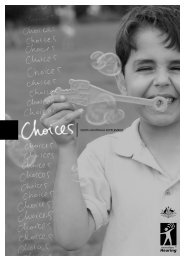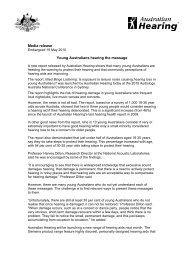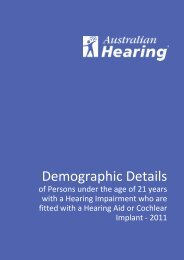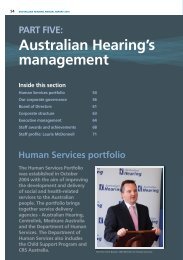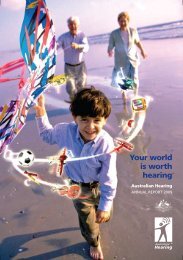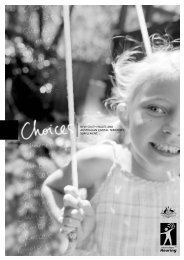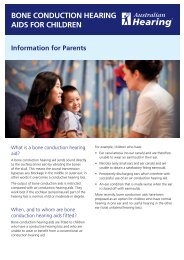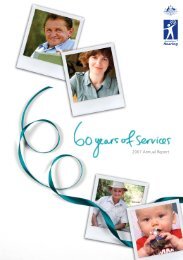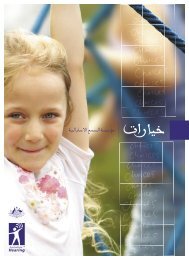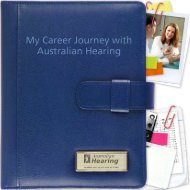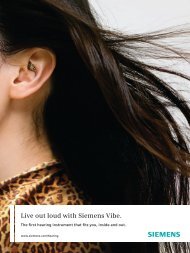Stralian Hearing Annual Report 2003â04 - Australian Hearing
Stralian Hearing Annual Report 2003â04 - Australian Hearing
Stralian Hearing Annual Report 2003â04 - Australian Hearing
You also want an ePaper? Increase the reach of your titles
YUMPU automatically turns print PDFs into web optimized ePapers that Google loves.
National Acoustic<br />
Laboratories<br />
“A critical source<br />
of information in<br />
hearing and noise<br />
in Australia and<br />
overseas.”<br />
Testing the reception of sound within the<br />
brain, using scalp electrodes, means hearing<br />
aid effectiveness can be assessed in infants.<br />
Over its 57-year history, the National Acoustic<br />
Laboratories’ (NAL) research into hearing and noise<br />
has improved the ways in which people with hearing<br />
loss can be helped. NAL continues to contribute to<br />
global research in acoustics, audiology, hearing aid<br />
development and hearing loss prevention. Research<br />
scientists present their work at <strong>Australian</strong> and<br />
international conferences and publish work in<br />
international journals and on the NAL website<br />
(www.nal.gov.au). NAL’s audiological procedures are<br />
widely recognised and adopted worldwide.<br />
NAL’s acoustic test facilities in Chatswood include a<br />
range of special-purpose rooms that are used for<br />
acoustical research, testing and measurement<br />
covering the full range of human hearing and<br />
extending into infrasonics. These facilities are also<br />
used to provide acoustical testing services for private<br />
industry and government.<br />
Infants’ hearing aids<br />
In the past year, NAL has made significant progress on<br />
a world-first study entitled Cortical Potentials which<br />
investigates the brain wave activity associated with<br />
sound. The aim of this study was to create technology<br />
to evaluate the effectiveness of infants’ hearing aids.<br />
Electrodes attached to the scalps of infants with<br />
normal hearing indicated that when the babies<br />
received different speech sounds, correspondingly<br />
different patterns of electrical activity emerged from<br />
the auditory cortex area of the brain. A similar result<br />
occurred for many hearing-impaired infants wearing an<br />
appropriately adjusted hearing aid. When these infants did<br />
not have hearing aids, or had hearing aids with insufficient<br />
amplification, no such patterns occurred.<br />
This new technology is becoming increasingly relevant and<br />
necessary now that NSW has introduced universal newborn<br />
screening for hearing loss. More hearing-impaired babies, as<br />
young as one month old, are now being fitted with hearing aids,<br />
and the research is expected to lead to an objective method to<br />
evaluate the appropriateness of the hearing aid fitting.<br />
Detecting differences<br />
NAL researchers have developed an automated statistically-based method to<br />
detect differences in brainwave patterns in infants in response to sound. This<br />
testing technique should be available commercially in a couple of years. The study<br />
results have been presented at <strong>Australian</strong> and international conferences.<br />
NAL research<br />
The high international prominence of procedures developed by NAL became<br />
evident during the year in two independent reviews.<br />
• A survey published in the <strong>Hearing</strong> Journal in the USA in October 2003, cited the<br />
NAL-Non linear 1 (NAL-NL1) prescription formulae as the most-used procedure<br />
for prescribing non-linear hearing aids in the USA, while the NAL-RP formula<br />
(for linear hearing aids) was the second most-used procedure.<br />
• A survey published in <strong>Hearing</strong> Review in the USA in June 2003, showed that<br />
the Client Oriented Scale of Improvement (COSI) procedure developed jointly<br />
by NAL and <strong>Australian</strong> <strong>Hearing</strong> clinicians was the most-used procedure for<br />
evaluating the outcomes of rehabilitation.<br />
Three research studies completed during the year were:<br />
• A study on Personal Stereo Noise Exposure found that one in four people<br />
surveyed listened at volumes and for times that were equivalent to listening<br />
at 85 dBA or higher for eight hours per day, placing them at risk of damaged<br />
hearing.<br />
• A study into the link between auditory processing disorders and reading ability<br />
showed that children who were poor readers were less able to process sounds<br />
within their auditory system than those who read well. The children studied<br />
were between eight and 12 years old.<br />
“More hearingimpaired<br />
babies,<br />
as young as one<br />
month, are now<br />
being fitted with<br />
hearing aids.”<br />
32 AUSTRALIAN HEARING ANNUAL REPORT 2003–04 NATIONAL ACOUSTIC LABORATORIES 33



